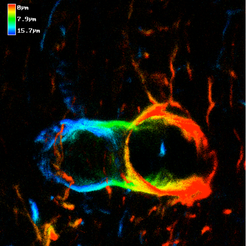Exploring glia in schizophrenia and depression

In recent years, researchers in the neurosciences have changed their focus of attention from neurons to glia. This “glial turn” has revealed new approaches and hypotheses for the healthy brain and its disorders. Recently, mood disorders, namely major depression, have been described as diseases mainly affecting glia and particularly astrocytes. We have validated the glial hypothesis of mood disorders in humans by measuring serum markers with meta-analyses, and cell culture models. We were able to show that the glial marker protein S100B is elevated in major depression. These elevations seem to be related to the severity of depression and might be used as treatment markers. In contrast, the neuronal marker protein neuron-specific enolase (NSE) is unchanged. However, increases of S100B are not specific for mood disorders. We and others detected the same alterations in schizophrenia that were particularly related to the “deficit syndrome” characterized by “negative symptoms”. Now, cell culture models of astrocytes, which we have also previously used to investigate the blood-brain barrier, are underway exploring drug effects specifically.
Related references:
M. L. Schroeter, J. Steiner
Elevated serum levels of the glial marker protein S100B are not specific for schizophrenia or mood disorders. Molecular Psychiatry 14(2009): 235-237. IF 12.5
M. L. Schroeter, H. Abdul-Khaliq, M. Krebs, A. Diefenbacher, I. E. Blasig
NSE is unaltered whereas S100B is elevated in serum of patients with schizophrenia – Original research and meta-analysis. Psychiatry Research 167(2009): 66-72. IF 2.3
M. L. Schroeter, H. Abdul-Khaliq, M. Krebs, A. Diefenbacher, I. E. Blasig
Serum markers support disease-specific glial pathology in major depression. Journal of Affective Disorders 111(2008): 271-280. IF 3.1
M. L. Schroeter
Das antioxidative System der Blut-Hirn-Schranke - Einfluß von Astrozyten sowie Hypoxie/Reoxygenierung.(The antioxidative system of the blood-brain barrier – influences of astrocytes and hypoxia/reoxygenation) Shaker-Verlag, Aachen, Germany, 2005. ISBN 978-3-8322-4626-6.
M. L. Schroeter, H. Abdul-Khaliq, A. Diefenbacher, I. E. Blasig
Serum S100B is increased during early treatment with antipsychotics and in deficit schizophrenia. Schizophrenia Research 62(2003): 231-236. IF 3.9
H. Abdul-Khaliq, S. Schubert, G. Stoltenburg-Didinger, M. Huebler, D. Troitzsch, A. Wehsack, W. Boettcher, B. Schwaller, M. Crausaz, M. Celio, M. L. Schroeter, I. E. Blasig, R. Hetzer, P. E. Lange
Release patterns of astrocytic and neuronal biochemical markers in serum during and after experimental settings of cardiac surgery. Restorative Neurology and Neuroscience 21(2003): 141-150. IF 1.4
M. L. Schroeter, H. Abdul-Khaliq, A. Diefenbacher, I. E. Blasig
S100B is increased in mood disorders and may be reduced by antidepressive treatment. NeuroReport 13(2002): 1675-1678. IF 2.5
M. L. Schroeter, S. Müller, J. Lindenau, B. Wiesner, U. K. Hanisch, G. Wolf, I. E. Blasig
Astrocytes induce manganese superoxide dismutase in brain capillary endothelial cells. NeuroReport. 12(2001): 2513-2517. IF 2.5
I. E. Blasig, H. Giese, M. L. Schroeter, A. Sporbert, D. I. Utepbergenov, I. B. Buchwalow, K. Neubert, G. Schonfelder, D. Freyer, I. Schimke, W. E. Siems, M. Paul, R. F. Haseloff, R. Blasig
(NO)-N-center dot and oxyradical metabolism in new cell lines of rat brain capillary endothelial cells forming the blood-brain barrier. Microvascular Research 62(2001): 114-127. IF 2.4
C. Csonka, T. Pataki, P. Kovacs, S. L. Müller, M. L. Schroeter, A. Tosaki, I. E. Blasig
Effects of oxidative stress on the expression of antioxidative defense enzymes in spontaneously hypertensive rat hearts. Free Radical Biology & Medicine 29(2000): 612-619. IF 5.6
M. L. Schroeter, K. Mertsch, H. Giese, S. Müller, A. Sporbert, B. Hickel, I. E. Blasig
Astrocytes enhance radical defence in capillary endothelial cells constituting the blood-brain barrier. FEBS-Letters 449(1999): 241-244. IF 3.8
K. Mertsch, R. F. Haseloff, M. L. Schroeter, I. E. Blasig
In vitro models of the blood-brain barrier for the investigation of cerebroprotective agents. In: A. J. Carter, H. Kettenmann (1999) Practical Handbook of Methods. Cell culture models as alternatives to animal experimentation for the testing of neuroprotective compounds in stroke research. Research Center Jülich GmbH, Jülich.
M. L. Schroeter
Das antioxidative System der Blut-Hirn-Schranke - Einfluß von Astrozyten sowie Hypoxie/Reoxygenierung.(The antioxidative system of the blood-brain barrier – influences of astrocytes and hypoxia/reoxygenation)
M.D. thesis, Humboldt-University Berlin, 1998. Available on the internet: http://dochost.rz.hu-berlin.de/dissertationen
I. E. Blasig, A. Sporbert, D. I. Utepbergenov, M. L. Schroeter, K. Mertsch, R. F. Haseloff
Cytokine- and hypoxia-induced lipid peroxidation in astrocytes. International Journal of Clinical Pharmacology & Therapy 36(1998): 112-113. IF 1.4
J. Steiner, M. Walter, P. Guest, A. M. Myint, K. Schiltz, B. Panteli, M. Brauner, H.-G. Bernstein, T. Gos, M. Herberth, M. L. Schroeter, M. J. Schwarz, S. Westphal, S. Bahn, B. Bogerts
Elevated S100B levels in schizophrenia are associated with insulin resistance. Molecular Psychiatry (2009): In Press. IF 12.5
J. Steiner, K. Schiltz, M. Walter, M. T. Wunderlich, G. Keilhoff, R. Brisch, H. Bielau, H.-G. Bernstein, B. Bogerts, M. L. Schroeter, S.Westphal
S100B serum levels are closely correlated with body mass index: An important caveat in neuropsychiatric research. Psychoneuroendocrinology (2009): In Press. IF 3.8
